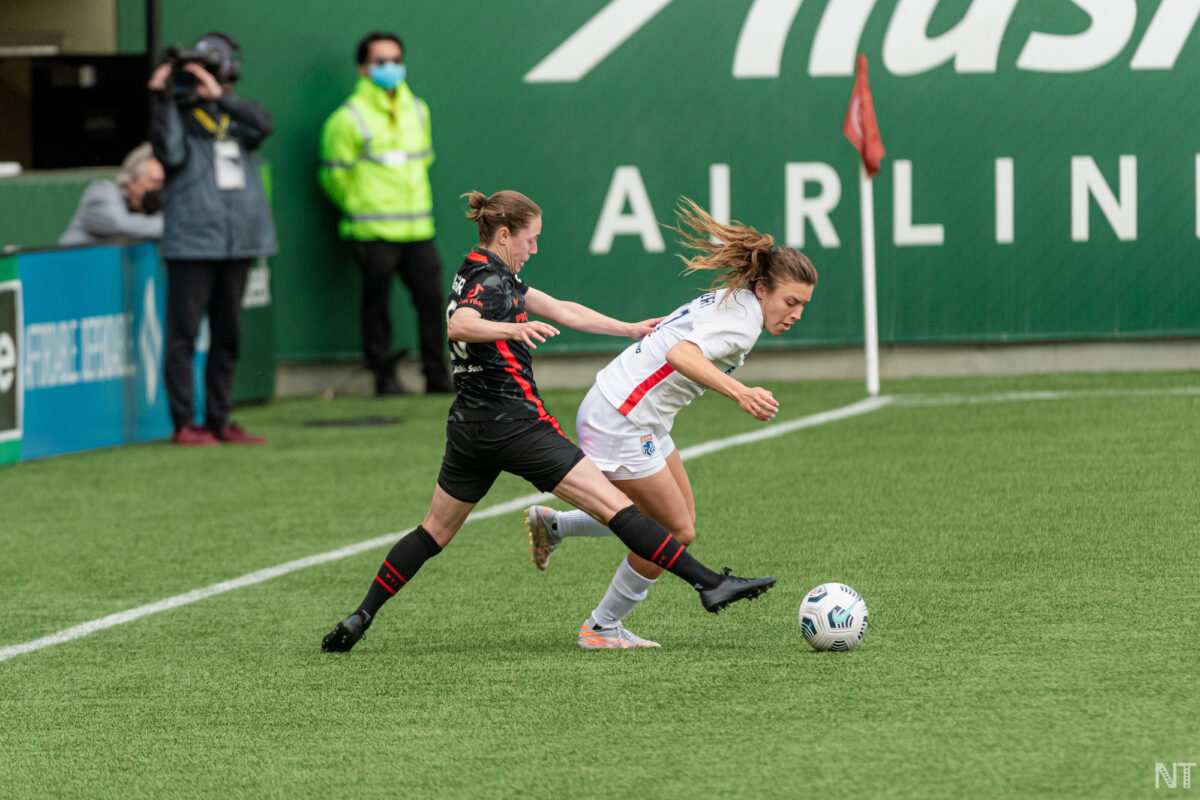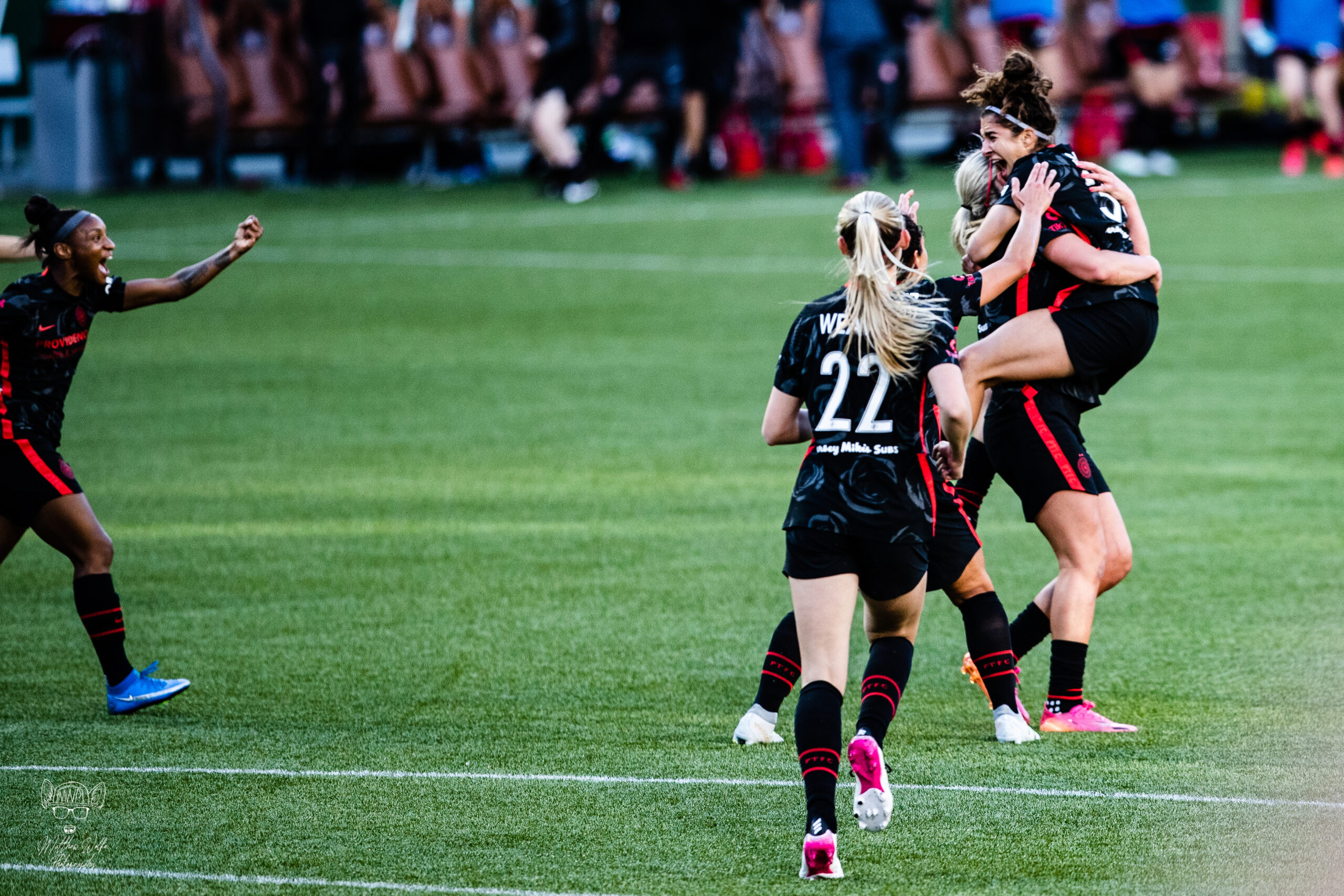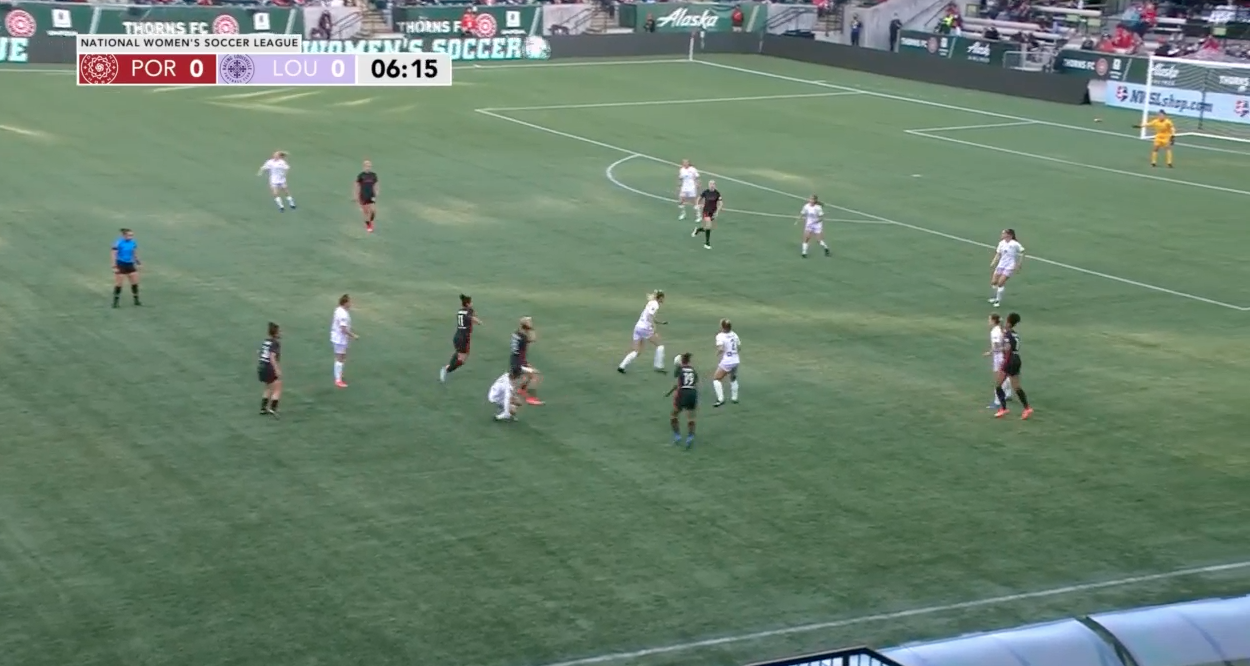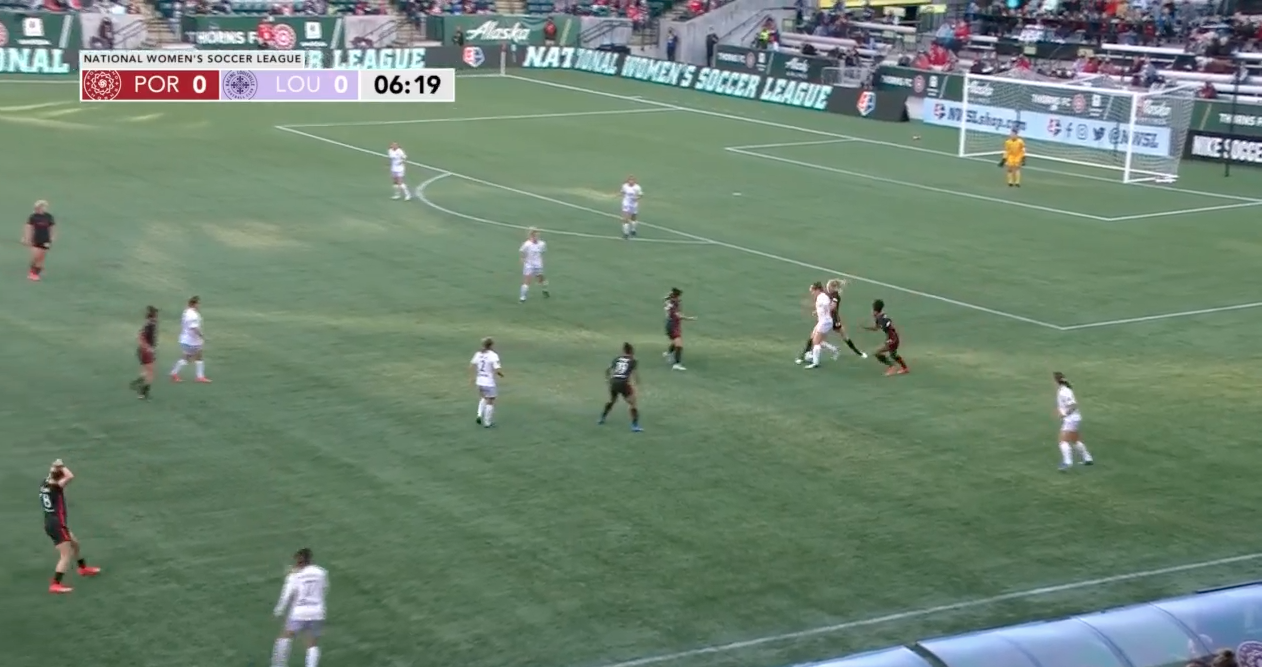To view this content, you must be a member of the Rose City Review Patreon
Already a qualifying Patreon member? Refresh to access this content.


The Thorns extended their unbeaten streak with a hard-fought 1–1 tie against the Orlando Pride yesterday evening, thanks to Simone Charley’s fourth headed goal of the season. The Thorns beat the Pride 2–1 just a few weeks ago, but that was before then-coach Marc Skinner abruptly left for Manchester United. The Pride they played tonight, under interim head coach Becky Burleigh, was more physical and harder to break down, but the Thorns were able to dig deep and find a point on the road.
At the outset, the Thorns appeared tight and disjointed. Despite only two changes to the starting eleven from the previous week—with Natalia Kuikka getting the start over Christen Westphal and Marissa Everett stepping in for an injured Celeste Boureille—the team struggled to find a rhythm in the early minutes. That was a departure from previous games, where they’ve started on the front foot: the Thorns have scored 11 times in the first 15 minutes this season, a league record.
Last night was a different story: defensively, the Thorns trailed in the first half, winning 43% of their duels. And it was the Pride who found the back of the net early with a header from Jodie Taylor in the 13th minute. The Pride’s initial run of momentum came off of a 4-v-1 battle against Sophia Smith at the top of the 18, where Smith was offered no support or options to get the momentum on Portland’s side.
After the break, though, the Thorns turned things around. In the postgame presser, Charley and Meghan Klingenberg both framed that change as a shift to “Thorns Soccer,” which refers to the core principles that the team follows. Basically, the players hold each other accountable, focus on process over results, and play the same way regardless of who’s on the field. This consistency allows for them build momentum through a game, to where they can score with ease and class.
And that’s what happened: Charley, who is absolutely on fire, recorded her fifth goal of the season off a free kick by Klingenberg that looked straight off of the training ground. Although the goal didn’t come until the 78 minute, the Thorns had been building for a goal throughout the second half. They recorded three shots on target (up from just one in the first half) and only allowed the Pride four shots total, which is much more typical of the Thorns’ dominant, offense-focused style.
After the game, the players talked about their first-half struggle in finding a rhythm and acting on what the other team was presenting them with. “Somebody is always going to be open, and we need to find that opportunity,” said Kling after the match. She added that once the Thorns are able to find open spaces in game and make adjustments on the fly, they’ll be “scary good.”
Watching that first-to-second-half shift, it’s clear that the Thorns are more than capable of making necessary tactical adjustments and executing plans, and it’s more of a matter of finding the confidence to adjust on the fly, rather than being too shaken to act without having to wait for a break to discuss what to do.
The Thorns Soccer that Charley and Kling discussed in the post-game conference was also present on an individual level. Parsons cited that nine players were out for this match, but that those absences showed the depth of the team culture, as players went a full 90 and didn’t relent.
With Portland’s five international players still out, many players have gotten more minutes than they did in the first half of the season, but the tactics that they employ don’t change. Angela Salem, who got deservedly high praise from Parsons postgame, had the second-most touches (77) and the most chances created (5), as well as boasting a 78% passing accuracy. She’s a pivotal player in the midfield, acting as the glue to help facilitate movement forward and maintain possession. Against Orlando, Salem was one of the most successful in exploiting the space that the Pride left open and has made an exceptionally strong case to keep her starting spot on the team, as her visions and consistency are emblematic of the Thorns culture that the team has been cultivating all season.
Another player it’s impossible not to talk about is Olivia Moultrie, who recorded her second professional start against the Pride and played 82 minutes, nearly double what she played last week. And although she recorded the second fewest touches with 39, her work ethic on the field to recover, pressure, and infiltrate the open space opens up the field for her teammates. Especially in the second half, Moultrie played end to end, making several tackles back in her own 18-yard box, showing that she has the mental fortitude to play with the Thorns.
As the Thorns head into a busy few weeks, with five games in sixteen days thanks to the Women’s International Champions Cup, it’s crucial that they maintain the momentum they have built during the Olympic period. For this team to succeed, every player has to deeply believe in the “Thorns Soccer” culture that allowed them to get back a point on the road against Orlando.

The Thorns coasted to a confident 3–0 win against Racing Louisville last night on the strength of goals by Angela Salem (!!!), Rocky Rodríguez, and Lindsey Horan. Although Louisville struggled to put together much of an attack, it was one of Portland’s most complete performances all year. Even with Christine Sinclair unavailable, their usual game plan worked exactly the way it was supposed to, and just as important, the gals showed progress against their perennial bugbear of ludicrously unlucky finishing.
On the defensive side of the ball, Portland’s press clicked last night better than it has all season, barring maybe the 5–0 Red Stars blowout. They didn’t do anything new, they just looked extremely well-organized at the same scheme they’ve been implementing all season.
In broad strokes, the Thorns’ pressing strategy in the defensive phase consists of encouraging their opponent to move wide, cutting off options into the center of the field, and trapping them on the wings. Here’s an example of how that worked last night:
Clip cortito y editado con energía de domingo, pero cada vez es más y más importante no solo presionar a la pelota, sino presionar espacios y presionar receptoras. Thorns hace esto de manera impecable. pic.twitter.com/OxL9zEM7eq
— Tony ⚡⭐⭐⭐🇦🇷 (@xGisfornerds) June 6, 2021
As Tony points out, most players aren’t pressing the ball here, but constricting the space and limiting Louisville’s options when it comes to passing centrally. After chasing the ball to outside back Emily Fox on the left wing, Fox only has one option, which is to pass backwards to center back Kaleigh Riehl. Riehl, in turn, has no options going forward and has to throw the ball away.
The Thorns also deployed a suffocating counter-press that bore fruit several times—including a moment that led indirectly to Salem’s opening goal in the eighth minute.
The Thorns have just lost possession here, but—because of Rodríguez, Weaver, and Horan cutting off passing lanes, and Simone Charley hovering near Fox—Louisville midfielder Freja Olofsson has nowhere to pass but straight back:

Riehl receives the pass, but quickly gets hemmed in herself, as Weaver and Charley both charge toward her, and Rodríguez and Dunn mark Olofsson and Fox, respectively, eliminating them both as options:

Dunn and Rodríguez close in and, with no remaining choice besides booting the ball to the moon, Riehl dribbles straight into the trap the four Thorns players have created:

From here, Weaver strips the ball off Riehl, dribbles a few yards to the left, and takes a powerful shot that bounces off a Louisville defender for a Thorns corner. Racing is sloppy clearing the ball on Kling’s initial service, and it eventually falls to Salem, who scores.
The midfield last night consisted of Salem, Rodríguez, Horan, and Dunn, who slotted in for Christine Sinclair as the captain had already departed for the international break. The beautiful thing about this group is that Dunn, Rodríguez, and Horan can all play any central midfield role, so what we saw was quite a bit of fluidity among the group. Dunn, nominally the No. 10, would drop deep fairly often, with Horan and Rodríguez often making runs into the box ahead of her. Salem, the No. 6, had the most restricted role, but still roamed quite a bit.
Heat maps for Dunn (left) and Salem (right) are below:

It’s clear which player is which. Salem, the No. 6, has more actions in Portland’s defensive half (of course, Portland spent most of their time attacking, so no one did a ton back there), while Dunn hung out a lot in the space between Louisville’s midfield and defense, as well as getting into the box. But there’s also non-negligible overlap between the two players; Dunn dropped deeper at times, and Salem also got forward into that same pocket outside the 18.
After the game, Salem noted that the midfield “felt really fluid” and explained the group has been working on their organization, saying, “Sometimes with [our] midfield, we’re not always balanced, because we have such an attacking mindset in there. The focus has really been on just creating balance and holding space and staying disciplined. I think the midfielders all did that tonight.”
Here are the two No. 8s, Horan (left) and Rodríguez (right):

These two have a little less freedom than Dunn, but only horizontally, as each of them mostly sticks to one side of the field. Vertically, they both spend significant time in both halves of the field.
Like the team’s press, none of this is new—what I wrote above is the definition of a box-to-box midfielder—but last night, it all snapped into place in a new way, with everyone choosing their moments to get forward while staying attuned to the movements of the other three and ensuring they weren’t leaving areas of empty space. Salem is the holding mid, but all three of the others could be seen playing deeper than her at times. This is what you get when you put together three players who are all among the best in the world at their preferred position, and almost as good at a handful of others, and give them a few months to train together.
One other thing I want to point out from those heat maps: Horan? She does a lot! We all know this, but even if you know it, she does more than you probably realize.
This was another very lopsided match: The Thorns registered 28 shots to Louisville’s 4, putting 12 on frame. Louisville had zero shots on target.
As dire as Racing’s offense was, however, it’s also worth noting that defensively, they put up more of a fight than Chicago in their big loss, or the Reign in their Challenge Cup match. Obviously, they didn’t succeed in stopping Portland’s attack, but there was visible organization in their press, so it’s not like they rolled out the welcome mat for the Thorns. In the first half, they won 25 duels to the Thorns’ 17. That dropped to 23 and 26, respectively, in the second half, likely as Louisville’s arduous journey to Portland caught up with them.
Finally, Portland significantly out-possessed and out-passed their opponents: 59.6% to 41.4%, and 517 to 375 total passes, respectively. As with the duel numbers, the second half was substantially more lopsided in both respects.